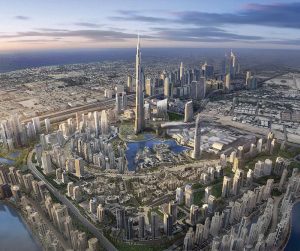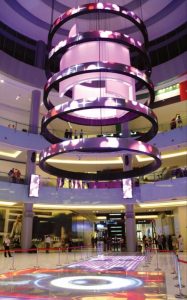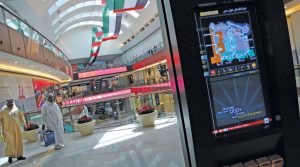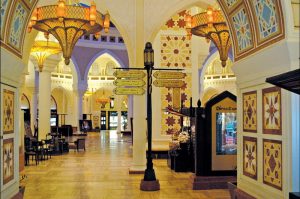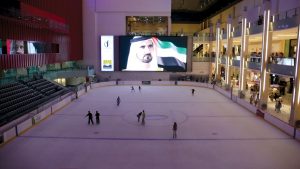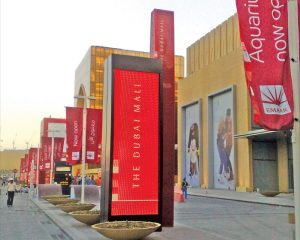Electric Signs
The Dubai Mall
A world-wonder, mixed-use shopping center
Published
15 years agoon
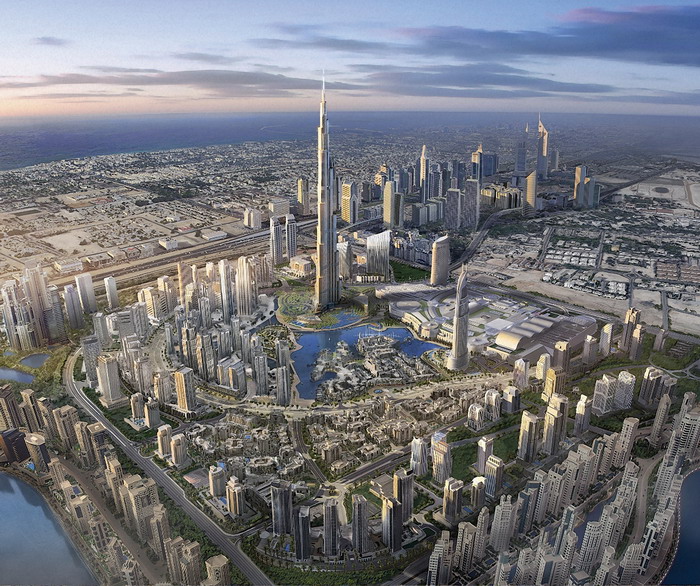
At 12 million sq. ft., the Dubai Mall is recognized as the largest mall and entertainment-destination center in the world. The mall is owned by Emaar Properties (Dubai, U.A.R.), one of the world’s largest, real-estate companies that has a collective presence in more than 36 markets that span the Middle East, North Africa, Pan-Asia, Europe and North America.
Emaar’s dream was to build a new, world-class, massive “downtown mall” within the Middle East interior and, thus, make a mall fit for a king and citizens alike.
When the Dubai Mall opened November 2008, the dream became reality. The mall has 6 million leasable sq. ft. of retail space, comprising 1,200 stores, spread throughout a four-story building filled with the familiar mix of anchor tenants (Galeries Lafayette, Debenhams, Bloomingdale’s and Marks & Spencer), specialty stores, gold and jewelry outlets, and food courts, plus a series of additional spectacular attractions and live-performance areas.
The mall’s size, however, sets it apart. It occupies enough space to hold 50, international-sized soccer fields. Its immensity underscores a potential issue: How does a visitor navigate through four floors of stores, courtyards, and dining and destination spectaculars, spread throughout its byways and hallways?
The wayfinding system ambitiously incorporates static print and digital signage. Also, an extensive, multi-platform advertising network helps connect visitors to the various parts of their shopping experience.
Many companies worked on various aspects of designing the mall’s infrastructure, but the companies highlighted in this article were involved with its signage design and implementation.
Square Peg (Oakland, CA), which was responsible for overall signage consulting, initiated much of the initial sign planning and design through its wayfinding guidelines, advertising-display concepts and the main LED spectacular, the Barco LED ring, which was installed in the Fashion Avenue section.
The Barnycz Group® (Baltimore) was responsible for management, development and overall integration of the mall’s multimedia advertising network, as well as developing the advertising content that flowed into the multimedia network.
AdvertisementCar 14,000, where are you?
Michael Moore, Square Peg’s managing director, described the Dubai Mall’s layout as one big building, with one floor below ground and three above ground, surrounded by three parking garages (with a total of 14,000 parking spaces). Square Peg’s challenge was to integrate a complete wayfinding system that functioned for each person’s total shopping experience, from parking the car, visiting the mall, and returning to the car – all easily navigated. Powerful signage dynamics provided for those conventional tasks to be accomplished.
How do find your car after you’ve parked it? Through color, iconography, naming conventions and a ticketing system.
Moore said, “The challenge was not only having enough parking for the daily influx of mall visitors, but, even more important, helping these visitors to remember which garage building and which floor [and location] they parked in.”
To help visitors remember where they parked their cars, it was intended that the parking structure be tied to certain colors. Each building was painted a distinct color and given an accompanying icon: green (plant icon), orange (desert icon) and blue (water icon). The alphabet serves as another garage-design element, with each succeeding letter assigned to each floor. Thus, if you remember your letter, you know what building and what floor. Finally, ticket dispensers in the mall-entry lobby also identify your entry location into the building and floor level.
Navigation maneuvers
Once visitors, particularly first-timers, enter the mall, they must gain an overall orientation to the venue space and the stores they intend to visit. To “humanize” the mall into a more manageable space, specific parts became neighborhoods (Galleria, Aquarium Walk, Fashion Walk, Waterfront Atrium, Discovery Center and Gold Souk). Each neighborhood has its own “feature piece” as an audience draw. The destination areas include:
• The world’s largest gold souk (an open-air market), at 500,000 sq. ft., is a gold and jewelry showcase with 200 retailers.
• The world’s largest aquarium holds the world’s largest, clear-glass viewing panel (108 x 26 ft.), as well as a clear-acrylic underwater tunnel for a close view of the aquarium.
• An Olympic-sized skating rink is accompanied by a large-format Barco screen.
• The Cineplex offers 22 screens.
• Fashion Avenue, dedicated to haute couture, includes a high-tech fashion runway and an overhead, circular video display.
• The Food Courtyard offers more than 160 food/beverage options.
• The Music Water Fountain includes the world’s largest, kinetic, aqua sculpture that “dances” to music and lights.
Visitor graphic communications
A sophisticated wayfinding system helps make mall navigation manage¬able and efficient. The Dubai Mall signage incorporates only Arabic and English, because most visitors are familiar with the two languages. To further simplify communications, the signage incorporates icons, which also identify various mall amenities, such as restrooms, prayer rooms, ATMs, parking and elevators. An interactive mall directory helps visitors find their desired destinations.
Moore said, “The challenge with the interactive directory was making it function in a cohesive way. For example, how do you organize the retail tenants into general, themed categories [apparel, jewelry, fashion and dining], where the directory would be listing all the tenants in both English and Arabic [that’s 2,800 listings], and make the directory legible and functional on a 42-in. LCD screen [the largest at that time]?”
Also, an interactive directory, Moore pointed out, functions as a “single user” display. At the mall, endless lines of people could form to search for their mall destinations.
The solution? A wayfinding, mixed-media station that incorporates a mall map that displays each floor in great detail. Next to the map, a digital, interactive display allows visitors to drill into the building floor plan and find a more direct route to their desired mall destinations. This facilitates the directory-review process, because some visitors could just check the map and be on their way, and others could interact with the digital display.
Multimedia network
Another critical mall-signage element, outdoor advertising, blan¬kets the site with both print and digital displays. The Barnycz Group® (Baltimore) coordinated its content development and implementation. The multimedia, experiential-design company designs, installs and operates corporate retail visions of their branding and advertising programs.
President Danny Barnycz said the Dubai Mall’s cohesive indoor/outdoor, media-marketing program was designed to become the mall’s “voice.” The full advertising system, known as the Dubai Mall Multimedia Network (DMMN), connects mall visitors to retail-tenant advertising, the ongoing daily special events and customer services that comprise the mall’s daily activities.
Barnycz integrated the advertising and media into at least 19 different-sized digital platforms (LCD and LED displays). The company also developed the content (in varying formats) that would flow through the DMMN and trained a local media staff to operate the system on a daily basis.
Advertising network
The Dubai Mall advertising network extends outdoors, with its Grand Drive Banners (including seven Barco LED vertical displays and seven lightboxes) and a series of Premiere Panels (161 building wraps).
Within the mall, static-print and digital-advertising opportunities include 172 LCD screens and 26 static-ad panels for the elevators; 314 classic, wall-mounted advertising panels deployed along common-space mall areas such as hallways; and ad panels hung from the sides of bridge walkways (called Link Bridges) that connect opposing ends of the atrium-separated floor areas.
The hoist system uses five, independent winches. Each winch each holds one ring at four hoist points. A custom sound system is also integrated within the atrium ring.
In the center of the rings, a series of illuminated panels are also individually controlled. The rings can be hung in many configurations, from one solid display to five, individual displays, at any atrium level. They can display visual imagery, music and live video feeds in conjunction with the below-ground fashion shows or general fashion themes presented as an ongoing display within the Fashion Walk.
Other Barco LED spectaculars involved the fabrication of several, critical, video-display installations, which include:
• Seven, vertical, LED banners (OLITE 612) that were installed outside along the Grand Drive entrance road to the Dubai mall;
• An indoor, full-color, video-display screen/scoreboard (ILITE12 tiles), which was installed with the mall’s Olympic-sized ice skating rink, and
• A series of two-meter-high, curved, LED displays (ILITE 6XP tiles), also installed along a circular perimeter within the Fashion Avenue atrium area.
With all the wonders of the Dubai Mall and its vast acreage of retail and destination sites under one roof, all its digital and print signage is the hallmark of navigation that helps the thousands of daily visitors and shoppers. Between the wayfinding, branding and advertising, presented in everything from print to the DMMN, the Dubai Mall’s signage keeps visitors informed and pointed in the right direction, and it all begins with one simple sign: “Welcome to Dubai Mall.”
Louis M. Brill is a journalist and consultant for high-tech entertain¬ment and media communications. He can be reached at (415) 664-0694 or louisbrill@sbcglobal.net
SPONSORED VIDEO
Introducing the Sign Industry Podcast
The Sign Industry Podcast is a platform for every sign person out there — from the old-timers who bent neon and hand-lettered boats to those venturing into new technologies — we want to get their stories out for everyone to hear. Come join us and listen to stories, learn tricks or techniques, and get insights of what’s to come. We are the world’s second oldest profession. The folks who started the world’s oldest profession needed a sign.
You may like
Advertisement
Subscribe

Magazine
Get the most important news
and business ideas from Signsofthetimes Magazine.
Advertisement
Most Popular
-

 Tip Sheet2 days ago
Tip Sheet2 days agoAlways Brand Yourself and Wear Fewer Hats — Two of April’s Sign Tips
-

 Business Management1 week ago
Business Management1 week agoWhen Should Sign Companies Hire Salespeople or Fire Customers?
-

 Women in Signs2 weeks ago
Women in Signs2 weeks ago2024 Women in Signs Award Winners Excel in Diverse Roles
-

 Real Deal3 days ago
Real Deal3 days agoA Woman Sign Company Owner Confronts a Sexist Wholesaler
-

 Editor's Note1 week ago
Editor's Note1 week agoWhy We Still Need the Women in Signs Award
-

 Maggie Harlow2 weeks ago
Maggie Harlow2 weeks agoThe Surprising Value Complaints Bring to Your Sign Company
-

 Line Time2 weeks ago
Line Time2 weeks agoOne Less Thing to Do for Sign Customers
-

 Product Buying + Technology1 week ago
Product Buying + Technology1 week agoADA Signs and More Uses for Engraving Machines

